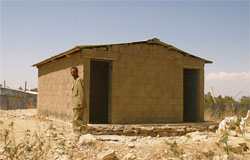13.2.3 Poor sanitary conditions: creating a research question
First read the following case study.
Case Study 13.1 Latrine coverage in kebele X
The sanitary conditions in kebele X are poor and very few households have latrines, perhaps only 5%. The diseases connected with poor sanitation, such as diarrhoeal diseases and intestinal worms, are very common. The woreda Health Office has therefore initiated a sanitation project that aims to increase the percentage of households with access to latrines by 15% each year. The project provides materials for latrine building, and the community members of the kebele should provide labour. However, two years later, less than half of the target has been reached (Figure 13.3).
Discrepancy: 35% of the households should have latrines after two years of the latrine-building project, but only 15% do have them.
Research question: What factors might explain this discrepancy?

Read Case Study 13.1 carefully. The situation with poor uptake of latrines has produced a clear research question. In Section 13.2.2 you learned about the two steps that might help to clarify a health problem. What two steps of further research do you think might help in clarifying the sanitation problem in Case Study 13.1?
Step 1: further research to help you find out more about the barriers to latrine construction, and if there are any specific factors affecting the slow progress towards achieving the target. Step 2: researching further details about the interventions that are currently in place will help you work towards answering the key research question about why so few latrines were built in the first two years of the project.
In every locality there will be a number of serious health issues that might benefit from further research. But how should these be prioritised? Which of these problems should be the subject of a small-scale research study?
13.2.2 Criteria for choosing health problems to research
